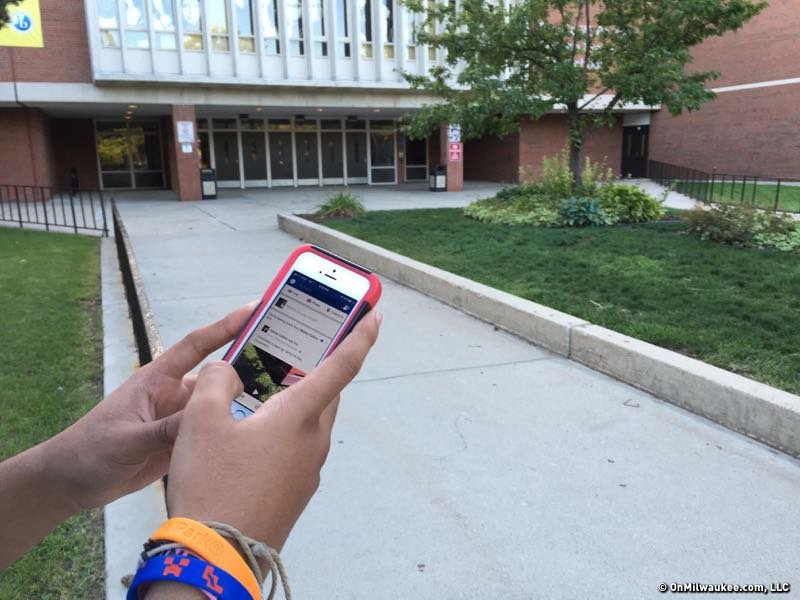Milwaukee high schools have very different policies on student cell phone use while on school grounds.
It seems high school cell phone policies are a microcosm of the differences between city public schools, suburban public schools and private religious schools. When the majority of the student body is from a privileged, higher income family, they are more likely to own a smartphone and they are granted the opportunity to use it freely. However, at high schools with poorer kids, also typically kids of color, cell phone use is limited or restricted.
Milwaukee Public Schools’ policy restricts students from activating, using or displaying cell phones, tablets, portable music players or any other social media device.
"Our goal is to provide an environment where students can focus on learning. These devices can be disruptive to that environment," says Katie Cunningham, the district's media relations supervisor.
Shorewood High School and Nicolet High School – both suburban public schools – have very different policies. Both schools allow students to have and use a cell phone during the school day, but with limitations.
"We leave it up to the teachers. Some forbid cell phone use during class, others want it out of sight when they are teaching, but are fine with students wearing headphones during work or study time," says Joe Patek, associate principal at Shorewood High School.
Greg Kabara is the principal of Nicolet High School and confirms that his school's policy is similar to Shorewood’s.
"Our students are able to have phones at school during the day at the discretion of their classroom teachers," says Kabara, who adds that the policy changed shortly before he became principal four years ago.
"Nicolet used to have a no-cell phone policy, but it became difficult to police when almost every student has a phone," he says.
The "no phone" policy also seemed counterproductive to the district’s goal of getting technology into the hands of every student to teach them how to efficiently access information as well as teach technology appropriateness.
"They figure out that it’s OK to text friends during lunch time, but not during class time," says Kabara.
Patek says Shorewood’s goal for the 2017-18 school year is for every student to have a device and that teaching kids how to properly and responsibly use technology makes more sense than forbidding it.
"The kids are going to have them for the rest of their lives. They are going to have phones in college and in the work force and it’s important they learn now how to be respectful of devices and use them appropriately," says Palek.
Whitefish Bay High School's policy is slightly more strictly worded, giving students permission to use devices if required by a teacher, but not for personal reasons.
According to the student handbook, "With the unending advancement of digital technology, there is ever greater opportunity to better advance student learning through its use. On the other hand, digital technology may also be used in ways that detract from student learning. Consequently, during instructional time, students may only use digital technology devices available to them (either personally owned or school provided) for teacher authorized purposes."
When contacted, Whitefish Bay assistant principal Kara Harmon declined to comment.
Private high schools' policies also differ. According to Messmer High School principal Todd Willems, students are not permitted to use a phone at any time during the school day unless requested by a teacher.
"We have this conversation yearly, and we look at what other Catholic high schools are doing," says Willem. "But for us it boils down to equality among students."
Messmer, a Catholic High School on Milwaukee’s near North Side, has a primarily African-American student population. Some students have smartphones, but many do not.
"We don’t want texting or social media to interrupt the learning process," says Willems.
Messmer students can use phones before and after school, but if they need to make a call during the day for any reason they must use the land line in the main office.
"For now, the minuses of kids using cell phones outweigh the pluses for us," says Willems. "But the balances are getting closer."
Marquette University High School, also a private Catholic high school, has the same policy as Messmer: no phones during the school day. The reasoning behind it is similar, with one added objective.
"Our goal is to have our students look at other people when they communicate," says Kriss Schulz, vice president of operations and communications at Marquette University High School.
According to numerous studies, one in four teens are "cell mostly" internet users, meaning they primarily go online via their phone rather than a laptop or desktop computer. In 2013, a Harvard University study determined that 78 percent of teens have a cell phone and 47 percent of those own smartphones.
The stricter MPS cell phone policy could be attributed to a much larger student body and safety issues. The policy was originally drafted in 2007 after two violent incidents took place at Bay View High School during which students used cell phones to call people outside the building to get involved in fights both inside and outside the building.
Some Milwaukee public high schools adhere to the policy more closely than others. In some high schools, students are permitted to listen to music with earbuds during study hours.
Rowan Chheda is a sophomore at Rufus King High School. He says cell phones are restricted, but the policy is not strictly enforced. Chheda, who, ironically, is currently without a cell phone because his broke a few weeks ago, thinks cell phones should be permitted, but within reason.
"Kids in high school should be allowed to use their phones for music and educational purposes – when it's appropriate – and with ear buds," says Chheda. "Restrictions make sense when the teacher is teaching."
The issue of safety and whether cell phones help or hinder it can be looked at in two entirely different ways. In city schools, there might be fear of phones being used to organize gang activity, but suburban districts often see them as integral to safety in the case of an emergency like a mass school shooting, which generally occur more in suburban environments.
Numerous districts around the country changed their policies to allow phones on site after the 1999 mass shooting at Columbine High School in Colorado.
Consequences if a student is caught using a cell phone during a restricted period also vary. Not surprisingly, the schools with the strictest policies also have the strictest consequences.
If MPS students are caught using a cell phone during school, the device will be confiscated, according to the district handbook.
"In the case of an emergency, parents can contact their student by calling their school office. Staff also will work with students to contact their parent or guardian if necessary," says Cunningham.
Marquette has a stringent policy, too. The phone is immediately taken away, and parents are required to come into the office to retrieve it. Although cell phones are "legal" at Shorewood and Nicolet, if students abuse the privilege of using them, they will receive a verbal warning and parents will become involved in extreme cases.
"This rarely happens," says Kabara. "Our students are doing a great job managing their devices."
Molly Snyder started writing and publishing her work at the age 10, when her community newspaper printed her poem, "The Unicorn.” Since then, she's expanded beyond the subject of mythical creatures and written in many different mediums but, nearest and dearest to her heart, thousands of articles for OnMilwaukee.
Molly is a regular contributor to FOX6 News and numerous radio stations as well as the co-host of "Dandelions: A Podcast For Women.” She's received five Milwaukee Press Club Awards, served as the Pfister Narrator and is the Wisconsin State Fair’s Celebrity Cream Puff Eating Champion of 2019.







